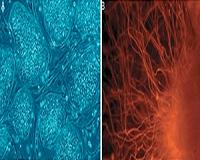 |
Houston TX (SPX) Nov 15, 2010 Gadonanotubes (GNTs) developed at Rice University are beginning to show positive results in a study funded by a federal stimulus grant through the National Institutes of Health (NIH) last year. The study has determined GNTs are effective in helping doctors track stems cells through the body by making them 40 times better than standard contrast agents used in magnetic resonance imaging. Contrast agents help doctors spot signs of disease or damage in MR images. Researchers at Rice and the Texas Heart Institute at St. Luke's Episcopal Hospital in Houston reported in the journal Biomaterials that mesenchymal stem cells drawn from pig bone marrow labeled with GNTs are easily spotted under MRI. The technique holds promise for tracking the progress of tagged cells as they travel through a patient's body. Ultimately, the team hopes the magnetic properties of tagged stem cells will allow doctors to manipulate them in vivo and direct cells to specific locations - in the heart, for instance - where they can heal damaged tissue. GNTs are carbon nanotubes that contain gadolinium, an element commonly used in designing contrast elements for use in MRI. Though toxic, gadolinium is chelated, or chemically bound, which makes it safer for injection into the body. But clinical agents like the gadolinium-based Magnevist cannot enter cells. However, GNTs can. Invented in the lab of Rice chemistry professor Lon Wilson in 2005, the nanotubes sequester bundles of gadolinium ions, which enhance contrast in MRIs but cannot escape their carbon cages. This makes them biologically inert and safe for tagging cells from within. The team found GNTs did not affect the stem cells' ability to differentiate into other types of cells or to self-renew, though work continues to characterize their ability to adhere to cell scaffolds under various conditions. Lesa Tran, a fourth-year graduate student in Wilson's lab, was the primary author of the paper, and Wilson was corresponding author. Co-authors were Rice graduate student Ramkumar Krishnamurthy; Raja Muthupillai, a senior physicist at St. Luke's; and of the Texas Heart Institute: Maria da Graca Cabreira-Hansen, a research scientist; James Willerson, president and medical director; and Emerson Perin, medical director of the Stem Cell Center.
Share This Article With Planet Earth
Related Links Rice University The Clone Age - Cloning, Stem Cells, Space Medicine
 Stem Cells: The Next Generation
Stem Cells: The Next GenerationMoffett Field CA (SPX) Oct 18, 2010 These findings warn that procreation in space may be fraught with peril. However, further research could help unlock ways to combat the negative effects that weightlessness has on people of all ages. The microgravity that astronauts experience orbiting Earth on the space shuttle or International Space Station can ravage their bodies on lengthy missions, atrophying muscles, weakening bones ... read more |
|
| The content herein, unless otherwise known to be public domain, are Copyright 1995-2010 - SpaceDaily. AFP and UPI Wire Stories are copyright Agence France-Presse and United Press International. ESA Portal Reports are copyright European Space Agency. All NASA sourced material is public domain. Additional copyrights may apply in whole or part to other bona fide parties. Advertising does not imply endorsement,agreement or approval of any opinions, statements or information provided by SpaceDaily on any Web page published or hosted by SpaceDaily. Privacy Statement |